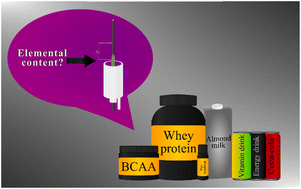Fast and simple analysis of the content of Zn, Mg, Ca, Na, and K in selected beverages widely consumed by athletes by flowing liquid cathode atmospheric pressure glow discharge optical emission spectrometry†
Abstract
An atmospheric pressure glow discharge (APGD) system, generated between a flowing liquid cathode (FLC) and a gas (He) jet anode, was applied for the determination of Zn, Mg, Ca, Na, and K in selected beverages commonly chosen by athletes (namely Coca-Cola Zero, energy and vitamin drinks, pre-workout, branched-chain amino acids, almond drink, and whey protein) by optical emission spectrometry (OES). In some cases (i.e., Coca-Cola, energy drink, and almond drink), sugared and sugar-free versions of the beverages were analyzed with the purpose of establishing the impact of added sugar on the analyte signal intensities. The analysis was performed after a simplified sample preparation procedure, which involved only their dilution and acidification with HNO3 to a concentration of 0.2 mol L−1. To determine the most suitable conditions for performing the analysis, optimization of the crucial operating parameters and sample dilution was carried out. Under the compromise conditions, the instrumental detection limits (DLs) were established and found to be 21, 0.91, 20, 0.062, and 0.14 μg L−1 for Zn, Mg, Ca, Na, and K, respectively. Due to the relatively low detection limits, the analyte content could be determined for a fairly high dilution, being concurrently the same for all analytes, which further simplified the whole procedure. It was found that the vast majority of samples could be determined using external calibration with simple standard solutions. The standard addition technique used for calibration was only required for the determination of Mg in three samples. The analysis results were consistent (in the majority of cases the recovery values were in the range of 88–111%) with the values obtained for the reference method (inductively coupled plasma optical emission spectrometry, ICP-OES), which proved the reliability of the results obtained from the developed FLC-APGD-OES system.

- This article is part of the themed collection: Analytical Methods HOT Articles 2023


 Please wait while we load your content...
Please wait while we load your content...